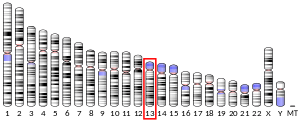GPR183
G-protein coupled receptor 183 also known as Epstein-Barr virus-induced G-protein coupled receptor 2 (EBI2) is a protein that in humans is encoded by the GPR183 gene.[5]
This gene was identified by the up-regulation of its expression upon Epstein-Barr virus infection of the Burkitt's lymphoma cell line BL41.[6] This gene is predicted to encode a G protein-coupled receptor that is most closely related to the thrombin receptor. Expression of this gene was detected in B-lymphocyte cell lines and lymphoid tissues but not in T-lymphocyte cell lines or peripheral blood T lymphocytes.[5]
EBI2 helps B cell homing within a lymph node. EBI2 expression increases during B cell activation, after B cell receptor and CD40 stimulation; its expression decreases during germinal cell development due to BCL6--a transcription factor required in germinal center development. EBI2 must turn off to move B cells to the germinal center from the periphery, and must turn on for B cells to exit the germinal center and re-enter the periphery.[7] EBI2 is a receptor for oxysterols, the most potent activator being 7α,25-dihydroxycholesterol.[8]
References
- 1 2 3 GRCh38: Ensembl release 89: ENSG00000169508 - Ensembl, May 2017
- 1 2 3 GRCm38: Ensembl release 89: ENSMUSG00000051212 - Ensembl, May 2017
- ↑ "Human PubMed Reference:".
- ↑ "Mouse PubMed Reference:".
- 1 2 "Entrez Gene: EBI2 Epstein-Barr virus induced gene 2 (lymphocyte-specific G protein-coupled receptor)".
- ↑ Birkenbach M, Josefsen K, Yalamanchili R, Lenoir G, Kieff E (Apr 1993). "Epstein-Barr virus-induced genes: first lymphocyte-specific G protein-coupled peptide receptors". J Virol. 67 (4): 2209–20. PMC 240341. PMID 8383238.
- ↑ Pereira JP, Kelly LM, Xu Y, Cyster JG (Aug 2009). "EBI2 mediates B cell segregation between the outer and centre follicle". Nature. 460 (7259): 1122–6. doi:10.1038/nature08226. PMC 2809436. PMID 19597478.
- ↑ Liu C, Yang X, Wu J, Kuei C, Mani N, Zhang L, Yu J, Sutton S, Qin N, Banie H, Karlsson L, Sun S, Lovenberg T (Jul 2011). "Oxysterols direct immune cell migration via EBI2". Nature. 475 (7357): 524–7. doi:10.1038/nature10280. PMC 4297623. PMID 21796212.
Further reading
- Maruyama K, Sugano S (1994). "Oligo-capping: a simple method to replace the cap structure of eukaryotic mRNAs with oligoribonucleotides". Gene. 138 (1–2): 171–4. doi:10.1016/0378-1119(94)90802-8. PMID 8125298.
- Suzuki Y, Yoshitomo-Nakagawa K, Maruyama K, et al. (1997). "Construction and characterization of a full length-enriched and a 5'-end-enriched cDNA library". Gene. 200 (1–2): 149–56. doi:10.1016/S0378-1119(97)00411-3. PMID 9373149.
- Strausberg RL, Feingold EA, Grouse LH, et al. (2003). "Generation and initial analysis of more than 15,000 full-length human and mouse cDNA sequences". Proc. Natl. Acad. Sci. U.S.A. 99 (26): 16899–903. doi:10.1073/pnas.242603899. PMC 139241. PMID 12477932.
- Gerhard DS, Wagner L, Feingold EA, et al. (2004). "The status, quality, and expansion of the NIH full-length cDNA project: the Mammalian Gene Collection (MGC)". Genome Res. 14 (10B): 2121–7. doi:10.1101/gr.2596504. PMC 528928. PMID 15489334.
- Rosenkilde MM, Benned-Jensen T, Andersen H, et al. (2006). "Molecular pharmacological phenotyping of EBI2. An orphan seven-transmembrane receptor with constitutive activity". J. Biol. Chem. 281 (19): 13199–208. doi:10.1074/jbc.M602245200. PMID 16540462.
This article incorporates text from the United States National Library of Medicine, which is in the public domain.




